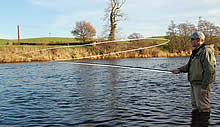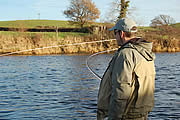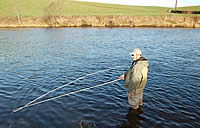The Snap "T" is another very useful cast for an upstream wind scenario, as the D loop, prior to the final delivery, is once again formed on the upstream side of the angler and is therefore much safer in these conditions.
 What differentiates the Snap "T" form the Circle "C" cast is the profile of the fly line in the air as it travels in an upstream direction. This is much narrower than the very open and circular shape created when using the Circle "C" cast. Bearing in mind the basic rule in fly casting is " the fly line will only follow the path of the rod tip as it moves through the air", then this tighter profile is obviously caused by a narrower or sharper downstream snap of the rod tip at the end of it's upstream journey. What differentiates the Snap "T" form the Circle "C" cast is the profile of the fly line in the air as it travels in an upstream direction. This is much narrower than the very open and circular shape created when using the Circle "C" cast. Bearing in mind the basic rule in fly casting is " the fly line will only follow the path of the rod tip as it moves through the air", then this tighter profile is obviously caused by a narrower or sharper downstream snap of the rod tip at the end of it's upstream journey.
 This downstream chop, or tuck, of the rod tip underneath the moving fly line (shown in the picture on the left) is designed to project your fly line, leader and fly in an upstream direction, the position of which is dictated by you as you move the rod tip upstream prior to returning it again to a position downstream of you and just above the water surface (pictured below). You are now ready for the next movement. This downstream chop, or tuck, of the rod tip underneath the moving fly line (shown in the picture on the left) is designed to project your fly line, leader and fly in an upstream direction, the position of which is dictated by you as you move the rod tip upstream prior to returning it again to a position downstream of you and just above the water surface (pictured below). You are now ready for the next movement.
By using this cast you can keep your fly line low to the water allowing you to access very difficult areas along the river bank such as overhanging trees that you would hit with the rod tip if using a Single Spey cast, or even hit with your fly (or flies) if using a Circle "C" cast as your fly (or flies) would follow the very open circular shape as it travels upstream. This is not the case with a Snap "T".
"So what next". Now that the rod tip has been returned to your downstream bank following the snap (as in the Circle "C" cast) the subsequent upstream sweep of the rod tip required to create your D loop can be made much flatter, and once again lower to the water (as long as it climbs gradually) making sure that you remain under the overhanging branches and not in them. You may find that the timing of your delivery will change to prevent the fly line sticking in the water.
 If your intension is to fish with longer sinking lines then this cast is not as efficient when it comes to digging your line out of the water with the initial snap. In this scenario, the Circle "C" would be the better choice of the two, as it allows you to move your rod tip through a longer distance to assist with drawing the sinking section of your fly line up to the surface during the initial movement of the cast. Alternatively you can use the Roll cast to roll your fly line and fly up onto the surface prior to the snap. If your intension is to fish with longer sinking lines then this cast is not as efficient when it comes to digging your line out of the water with the initial snap. In this scenario, the Circle "C" would be the better choice of the two, as it allows you to move your rod tip through a longer distance to assist with drawing the sinking section of your fly line up to the surface during the initial movement of the cast. Alternatively you can use the Roll cast to roll your fly line and fly up onto the surface prior to the snap.
Depending on your situation, variations in the angle of your rod tip building up to the initial snap can be quite useful and is worth experimenting with, as well as combining the Snap "T" with the Circle "C" cast to create a hybrid of the two, (often lightheartedly referred to as a Snurkle) which many of us already do.
For further information on the Snap T and Circle "C" casts you can view a more in depth article in a PDF document on the following link Click here. This article can also be accessed from the bottom of the Home Page under the heading of Six of the Best Spey Casts.
< Back |
